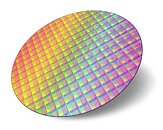Friday, December 6th 2019

TSMC on Track to Deliver 3 nm in 2022
TSMC is delivering record results day after day, with a 5 nm manufacturing process starting High Volume Manufacturing (HVM) in Q2 next year, 7 nm process getting plenty of orders and the fact that TSMC just became the biggest company publicly trading in Asia. Continuing with the goal to match or even beat the famous Moore's Law, TSMC is already planning for future 3 nm node manufacturing, promised to start HVM as soon as 2022 arrives, according to JK Wang, TSMC's senior vice president of fab operations. Delivering 3 nm a whole year before originally planned in 2023, TSMC is working hard, with fab construction work doing quite well, judging by all the news that the company is releasing recently.
We can hope to see the first wave of products built using 3 nm manufacturing process sometime around end of year 2022, when the holiday season arrives. Usual customers like Apple and HiSilicon will surely utilize the new node and deliver their smartphones with 3 nm processors inside as soon as the process is ready for HVM.
Source:
DigiTimes
We can hope to see the first wave of products built using 3 nm manufacturing process sometime around end of year 2022, when the holiday season arrives. Usual customers like Apple and HiSilicon will surely utilize the new node and deliver their smartphones with 3 nm processors inside as soon as the process is ready for HVM.

71 Comments on TSMC on Track to Deliver 3 nm in 2022
After all, between flooding, viruses and the occasional fire, 2022 is very far away.
Let's see how 5nm rolls out in 2021.
But just look at the progress! 7, 5, 3! Unbelievable.
They could have just called it TURBO, MAX or MEGA.
It's all just a marketing name by now.
It's just a waste of time that gamers got pulled into this so easily. No one cares about important stuff anymore.
Adding EUV layers has little to do with performance and usually not that much with power efficiency. It is all about manufacturing, both ease/accuracy and speed of it. Both of these have implications for performance but are not done directly for that.
There are few different 7nm processes and it is just confusing now.
6nm will be an improved (more dense) 7nm+. Just like 7nm+ is improved (more dense) 7nm - despite still being called "7".
5nm will be a new design.
It's free market and these values aren't regulated (like e.g. 1 gram is, so you're not allowed to sell smaller chocolate bars because your "gram" is smaller).
There's an informal, industry standard for naming (ITRS/IRDS) and if we looked at that, TSMC's 7nm is almost exactly ITRS's 10nm. Again: TSMC's 5nm is more like "industry 7nm".
But since TSMC could change the naming and look more advanced, they did.
It seems they're stepping back a bit lately, with their product names shifting to the Nx notation. 7nm became N7, 7nm++ is N6 etc.
But as I said: they could just use any idiotic naming like "Ti BOOST" or "EPYC".
Adidas makes a shoe called "AlphaEdge 4D Shoe - Star Wars" and hell yeah, I want that!
That being said, if TSMC stayed with the IRDS naming, this would be called 10nm, so it would launch just few months before Intel's.
But calling it 7nm makes the impression that they're leading by 3 years.
And they're already announcing "5nm" and "3nm" as if they've found a spaceship full of unknown technology. :)
But the news is about TSMC being where they wanted to be now, not in 2022 or any year in between.
www.bloomberg.com/quote/700:HK
Tencent is second. TSMC may be third at best.
PCN 117291-01 (pdf)
"Intel(R) Pentium(R) Processor G3420 (3M Cache, 3.20 GHz) FC-LGA12C, Tray, PCN 117291-01, Product Discontinuance, End of Life, Reason for Revision: Cancelling this Product Discontinuance completely per new roadmap decision and enabling the product once again."
The end-of-the-line for silicon is near.
"biggest company publicly trading in Asia"
Should be "publicly traded in Asia", but wording is still not ideal.
"biggest company listed on an Asian stock exchange" would be precise.
And as mentioned by @LFaWolf, it's at best second largest.
But you're right, earthquakes, and let's not forget climate change either.